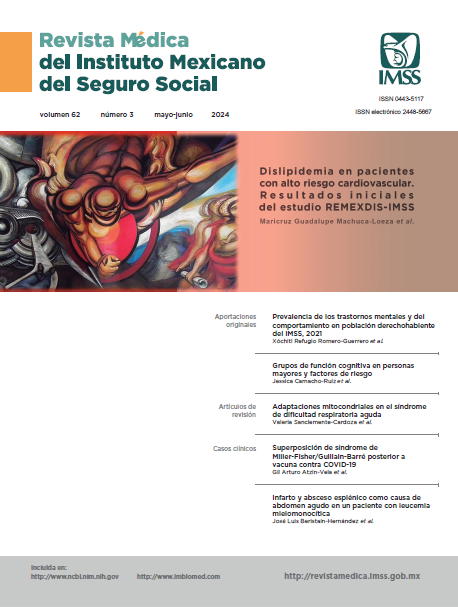Factores asociados de dependencia física en adultos con fractura de cadera
##plugins.themes.themeEleven.article.main##
Palabras clave
Fracturas de Cadera, Calidad de Vida, Hemiartroplastía, Estado Funcional
Resumen
Introducción: las fracturas de cadera afectan la calidad de vida y pueden causar dependencia física, en especial en adultos mayores.
Objetivo: determinar si el tratamiento quirúrgico y otros factores están asociados a dependencia para realizar actividades de la vida diaria en pacientes ancianos con fractura de cadera.
Material y métodos: estudio transversal analítico llevado a cabo en un hospital general de zona de enero 2019 a diciembre 2021. Fueron incluidos pacientes intervenidos quirúrgicamente por fractura de cadera. Después de 6 meses de la cirugía, se aplicaron los cuestionarios: Índice de Barthel y EQ-5D. Para el análisis de los datos, se utilizaron medidas sumarias y de asociación.
Resultados: se incluyeron 126 pacientes con promedio de edad de 78 ± 9 años. Los pacientes con fracturas subcapitales y basicervicales tratados con hemiartroplastía presentaron mayor dependencia comparados con los pacientes tratados con artroplastia total de cadera, con diferencia estadísticamente significativa. Se demostró que a mayor edad se tiene una mayor dependencia (p < 0.001), así como una estancia hospitalaria prolongada (p = 0.018). La cardiopatía fue la comorbilidad que presentó asociación con una mayor dependencia (p = 0.006).
Conclusión: el tipo de cirugía se presentó como un factor asociado a dependencia en los pacientes con fracturas subcapitales y basicervicales tratados con hemiartroplastía. El tiempo de estancia hospitalaria y la presencia de cardiopatía también se asociaron a dependencia física.
Referencias
Izaguirre A, Delgado I, Mateo-Troncoso C, et al. A. Rehabilitación de las fracturas de cadera. Revisión sistemática. Acta Ortop Mex. 2018;32(1):28-35.
Mattisson L, Bojan A, Enocson A. Epidemiology, treatment and mortality of trochanteric subtrochanteric hip fractures: data from the Swedish fracture register. BMC Musculoskelet Disord. 2018;19(1):369.
Viveros-García JC, Torres-Gutiérrez JL, Alarcón-Alarcón T, et al. Fractura de cadera por fragilidad en México: ¿En dónde estamos hoy? ¿Hacia dónde queremos ir? Acta Ortopédica Mexicana. 2018;32(6):334-41.
Veronese N, Maggi S. Epidemiology and social costs of hip fracture. Injury. 2018;49(8):1458-60.
Kijima H, Yamada S, Kawano T, et al. Characteristics and Treatment Strategies for Basicervical and Transcervical Shear Fractures of the Femoral Neck. J Clin Med. 2023;12(22):7024. doi: 10.3390/jcm12227024.
Toro G, Pola E, Miranda R, et al. Extracapsular femoral neck fractures treated with total hip arthroplasty: identification of a population with better outcomes. Orthop Rev (Pavia). 2022;14(6):38576. doi: 10.52965/001c.38576.
Mercouris M, Klopper S, Swanepoel S, et al. Conservative Management of Stable, Minimally Displaced Pertrochanteric Fractures: A Case Series. J West Afr Coll Surg. 2023;13(1):91-5. doi: 10.4103/jwas.jwas_223_22.
Zilmer CK, Kristensen MT, Magnusson SP, et al. Intensified acute in-hospital physiotherapy for patients after hip fracture surgery: a pragmatic, randomized, controlled feasibility trial. Disabil Rehabil. 2023:1-10. doi: 10.1080/09638288.2023.2288672.
Gnanendran D, Yanaganasar Y, Rajan JM, et al. Clinical Effectiveness of Total Hip Arthroplasty Compared with Hemiarthroplasty in Adults Undergoing Surgery for Displaced Intracapsular Hip Fracture: A Single-Centre Retrospective Cohort Study. Cureus. 2023;15(9):e45807. doi: 10.7759/cureus.45807.
Geetala R, Wakefield E, Bradshaw F, et al. M. Comparison of intra-operative outcomes following internal fixation with trochanteric stabilisation plate or intramedullary nail in intertrochanteric fractures. Eur J Orthop Surg Traumatol. 2023. doi: 10.1007/s00590-023-03779-5.
Keppler AM, Holzschuh J, Pfeufer D, et al. Postoperative physical activity in orthogeriatric patients – new insights with continuous monitoring. Injury. 2020;51(3):628-32.
Regenbogen S, Leister I, Trulson A, et al. Early Stabilization Does Not Increase Complication Rates in Acetabular Fractures of the Elderly: A Retrospective Analysis from the German Pelvis Registry. J Clin Med. 2023;12(22):7043. doi: 10.3390/jcm12227043.
Welsh A, Hanson S, Pfeiffer K, et al; Hip Helper Study Collaborators. Perspectives of informal caregivers who support people following hip fracture surgery: a qualitative study embedded within the HIP HELPER feasibility trial. BMJ Open. 2023;13(11):e074095. doi: 10.1136/bmjopen-2023-074095.
McLaughlin MA, Orosz GM, Magaziner J, et al. Preoperative status and risk of complications in patients with hip fracture. J Gen Intern Med. 2006;21(3):219-25.
Sanz-Reig J, Salvador Marín J, Ferrández Martínez J, et al. Prognostic factors and predictive model for in-hospital mortality following hip fractures in the elderly. Chinese J Traumatol. 2018;21(3):163-9.
Forni C, Gazineo D, D'Alessandro F, et al. Predictive factors for thirty day mortality in geriatric patients with hip fractures: a prospective study. Int Orthop. 2019;43(2):275-81. doi: 10.1007/s00264-018-4057-x.
Jayasinghe G, Kumar R, Buckle C, et al. Patient mortality after total hip arthroplasty revision surgery. J Orthop. 2023;47:45-9. doi: 10.1016/j.jor.2023.11.020.
Zhao Y, Alderden J, Missbrenner N. Dementia and Postoperative Delirium in Surgical Hip Fracture Patients: Unveiling Contrasting Risk Factors and Implications. J Gerontol Nurs. 2023;49(12):25-30. doi: 10.3928/00989134-20231108-03.
Yang TI, Kuo YJ, Huang SW, et al. Minimal short-term decline in functional performance and quality of life predicts better long-term outcomes for both in older Taiwanese adults after hip fracture surgery: a prospective study. J Orthop Surg Res. 2023;18(1):791. doi: 10.1186/s13018-023-04278-3.
Chen L, Jiang JB, Ma H, et al. Factors associated with early failure of the femoral neck system (FNS) in patients with femoral neck fractures. BMC Musculoskelet Disord. 2023;24(1):912. doi: 10.1186/s12891-023-06994-7.
Tarazona-Santabalbina FJ, Ojeda-Thies C, Figueroa Rodríguez J, et al. Orthogeriatric Management: Improvements in Outcomes during Hospital Admission Due to Hip Fracture. Int J Environ Res Public Health. 2021;18(6):3049. doi: 10.3390/ijerph18063049.
Pech-Ciau BA, Lima-Martínez EA, Espinosa-Cruz GA, et al. Fractura de cadera en el adulto mayor: epidemiología y costos de la atención. Acta Ortop Mex. 2021;35(4):341-7.
Zhang X, Zhang A, Yang X. Clinical study on the effect of intramedullary fixation and extramedullary fixation on unstable intertrochanteric fractures. Ann Palliat Med. 2021;10(12):12857-66. doi: 10.21037/apm-21-3635.
Duymus TM, Aydogmus S, Ulusoy I, et al. Comparison of Intra- and Extramedullary Implants in Treatment of Unstable Intertrochanteric Fractures. J Clin Orthop Trauma. 2019;10(2):290-5. doi: 10.1016/j.jcot.2018.04.003.
Slobogean GP, Sprague S, Bzovsky S, et al. Fixation using Alternative Implants for the Treatment of Hip Fractures (FAITH-2): The Exploratory Health-Related Quality of Life and Patient-Reported Functional Outcomes of a Multi-Centre 2 × 2 Factorial Randomized Controlled Pilot Trial in Young Femoral Neck Fracture Patients. Injury. 2021;52(10):3051-9. doi: 10.1016/j.injury.2021.02.030.


